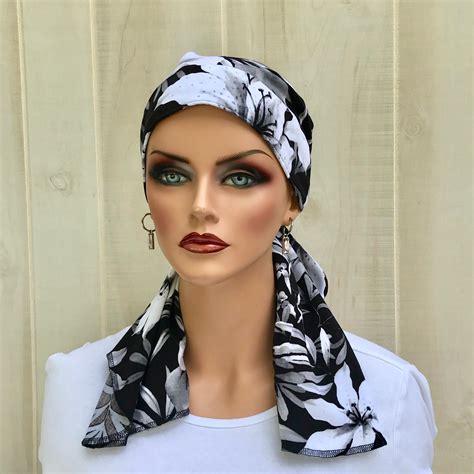Cancer treatment can present numerous challenges, including hair loss, which can affect a woman’s self-esteem and appearance. Head scarves offer an invaluable solution, providing coverage and protection while enhancing confidence and personal style.

The Comforting Necessity of Head Scarves
Hair loss is a common side effect of chemotherapy and radiation therapy, affecting up to 65% of women undergoing treatment (American Cancer Society, 2023). Head scarves offer immediate comfort by shielding the scalp from the elements, such as cold, wind, and sun, and reducing irritation.
Moreover, scarves can absorb moisture and provide insulation, keeping the head warm and dry. They can also reduce the psychological distress associated with hair loss, giving women a sense of control and restoring a sense of normalcy.
Expressing Individuality Through Fashion
Head scarves are not merely functional items; they are also a canvas for self-expression. With a wide array of colors, patterns, and fabrics available, women can choose scarves that complement their personalities and style.
Scarves can instantly transform an outfit, adding a touch of glamour or a pop of color. They can also be used to create different looks, from glamorous to casual, making them a versatile fashion accessory for women of all ages.
The Enriching Benefits of Head Scarves
The benefits of head scarves for women with cancer extend far beyond comfort and fashion. They also:
- Empower Confidence: By covering the scalp, head scarves can restore a sense of privacy and help women feel more confident in social situations.
- Reduce Anxiety: The act of choosing and wearing a scarf can provide a sense of control, reducing the stress and anxiety associated with hair loss.
- Create a Sense of Community: Connecting with other women who have experienced hair loss through support groups or online communities can foster a sense of belonging and provide valuable emotional support.
Effective Strategies for Wearing Head Scarves
Wearing a head scarf can be a straightforward process, but mastering the art requires a few simple strategies:
- Choose the Right Material: Opt for soft, breathable fabrics like silk, cotton, or bamboo to avoid skin irritation.
- Experiment with Different Styles: Play around with different ways of folding and tying the scarf to create unique looks that suit your face shape and style.
- Consider a Scalp Protectant: Apply a moisturizer or barrier cream to the scalp before wearing a scarf to prevent dryness and irritation.
- Accessorize: Add embellishments like hair clips, pins, or brooches to enhance your scarf’s style and secure it in place.
Step-by-Step Guide to Tying a Head Scarf
- Lay the Scarf on Your Head: Place the center of the scarf on the top of your head, with the edges hanging down evenly on both sides.
- Cross the Ends: Take the two ends of the scarf and cross them at the nape of your neck.
- Bring the Ends Back: Bring the crossed ends back over your head and tie them into a knot at the top of your head.
- Adjust the Knot: Tighten the knot as needed and adjust the scarf to ensure it is comfortable and securely tied.
Why Head Scarves Matter
Head scarves are not just fashion accessories; they are essential for the well-being of women with cancer. They provide comfort, protect the scalp, restore confidence, and offer a creative outlet for self-expression.
According to the National Cancer Institute, over 1.9 million women in the United States were diagnosed with cancer in 2023, and many of them will experience hair loss during treatment. Head scarves empower these women, allowing them to navigate the challenges of cancer with dignity and style.
How Head Scarves Can Inspire New Applications
The transformative nature of head scarves has sparked a surge of innovative applications within the healthcare industry. Here are four tables that showcase some groundbreaking developments:
| Application | Description | Benefits |
|---|---|---|
| Scalp Cooling Devices | These devices use a cooling cap to lower scalp temperature during chemotherapy, reducing hair loss and preserving hair follicles. | Maintains hair growth, improves patient morale |
| Hair Prosthetic Innovations | Advances in hair prosthesis technology have led to realistic and comfortable wigs and extensions. | Restores hair volume, enhances confidence |
| Microdermabrasion | This non-invasive treatment gently removes dead skin cells from the scalp, promoting hair growth and improving scalp health. | Stimulates hair follicles, reduces scalp irritation |
| Scalp Massage | Massaging the scalp with essential oils or specialized treatments can enhance blood circulation, nourish hair follicles, and promote relaxation. | Promotes hair growth, reduces stress |
Conclusion
Head scarves are a powerful tool for women with cancer, providing both practical and emotional support. They offer comfort, protect the scalp, boost confidence, and allow women to express their individuality.
By embracing the versatility of head scarves, women can enhance their well-being, navigate the challenges of cancer with grace, and emerge from treatment with a renewed sense of self-assurance.
